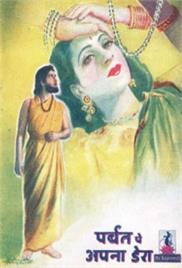Be Careful of Fake Websites. Always use HindiMovies.to domain & Join our Telegram Channel for Latest Updates.

Likes: 0
Views: 1.33K
Meera Devi played by Vanmala is a beautiful, rich heiress who is blind and seeks refuge with her father in Bhagwaan Shiva’s temple. There she meets an “ascetic” Ram Babu played by Ullhas who has no worth for worldly pleasures or people, having devoted himself to worship of the god Shiva. Meera pleads with him to allow her to serve him and he takes pity on her and restores her eyesight with his holy medicine. With love and gratitude she starts serving him and they fall in love and get married. Introduced to the pleasures of life, Ram Babu is waylaid and seeks extra-marital pursuits. Distraught Meera drives him away from her house and his eyes get burnt during Dassehra festivities while chasing her friend. It is then he realizes his mistakes and once again seeks refuge in God. Will Meera be able to re instate her lost love?
Released: 1944
IMDb Rating: N/A/10 (N/A Votes)
Genre: Drama, Hindi Movies
Stars: Vanamala, Madan Mohan
Directors: Rajaram Vankudre Shantaram
Writers: Dewan Sharar
Year: 1944
Server 1 – Youtube
Server 2 – Youtube
Server 3 – Youtube
Watch Part 1
Watch Part 2
Watch Part 3
Watch Part 4
Watch Part 5
Watch Part 6
Watch Part 7
Watch Part 8
Watch Part 9
Watch Part 10
Watch Part 11
Watch Part 12
Watch Part 13
Parbat Pe Apna Dera (1944): A Classic Bollywood Drama That Echoes Through Time
The year 1944 was a significant period in Indian cinema, marked by a blend of artistic storytelling and musical richness. Among the films that stood out during this era was "Parbat Pe Apna Dera," a Hindi-language drama that captivated audiences with its engaging narrative and compelling performances. Directed by someone who contributed profoundly to the Indian film industry during the 1940s, this movie remains a testament to the golden age of Bollywood.
Plot Overview
"Parbat Pe Apna Dera" translates to "Our Abode on the Mountain," a title that itself evokes a sense of mystique and emotional depth. Though detailed plot summaries are sparse due to the age of the film, the movie is known to encompass themes typical of Bollywood dramas of that era — exploring relationships, human values, and societal issues with an emotional poignancy that resonated with the audiences of the time.
The drama likely delves into complex characters set against a backdrop that metaphorically or literally involves mountainous terrain, symbolizing challenges and aspirations. The narrative might revolve around love, sacrifice, or social conflicts, crafted to evoke empathy and connect with the viewers on a personal level.
Main Cast and Characters
Both actors had significant careers in the Indian film industry, contributing to its development and popularity during the 1930s and 1940s.
Direction and Writing
While specific details about the director and writer are not widely documented, the film’s creation involved talented individuals who understood the cinematic language of Hindi cinema during the pre-independence era of India. Their storytelling displayed a nuanced understanding of human emotions, social patterns, and cultural narratives, essential to crafting a memorable drama.
The direction likely emphasized mood-setting through scenic locations suggested by the title—mountainous landscapes that heighten the dramatic tone. The screenplay was presumably structured to balance engaging dialogues with the emotional arcs of the characters, weaving a narrative that retained audience interest from start to finish.
Musical Element
Music has always been a relevant component of Bollywood films, enhancing the storytelling and emotional resonance. Although "Parbat Pe Apna Dera" does not have widely circulated information about its soundtrack and singers, typical films of this era integrated classical and folk music styles.
It is reasonable to infer that the movie featured melodious songs performed by playback singers or actors themselves, accompanied by traditional instruments that added authentic regional flavor to the film’s atmosphere. The songs likely complemented the dramatic elements — whether portraying love, sadness, or conflict — and helped elevate the narrative impact.
Cultural and Historical Significance
As a film released during the 1940s, "Parbat Pe Apna Dera" was part of a transformative period in Indian cinema, just before the country gained independence. Films of this time often contained subtle social commentaries or depicted the aspirations of common people amidst changing political landscapes.
This movie contributes to the legacy of classic Bollywood dramas that embraced storytelling with heart and authenticity. It serves as an important piece reflecting the style, values, and cinematic techniques of its era.
Conclusion
"Parbat Pe Apna Dera" is more than just a movie from 1944; it’s a cultural artifact encapsulating the essence of Indian drama cinema’s formative years. With impactful performances by Vanamala and Ulhas, and a storyline that presumably entwines emotion, social themes, and dramatic tension, it stands as an example of how films can serve as windows into the past.
For cinephiles and historians alike, revisiting such classic films enriches the understanding of Bollywood’s evolution and provides a glimpse into the artistic expressions that shaped Indian cinematic narratives.